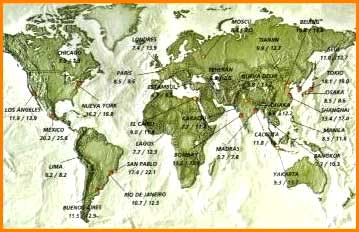|
The primitive human
groups did not live in fixed places;
they transferred from a site to another
one looking for water and food, until
they began to cultivate the ground,
activity that it demanded to them
to settle down, at least, temporally.
The possibilities
that agriculture offered, the own
necessities of the organization of
available resources impelled them
to group themselves in conglomerates.
Thus the city arose like an isolated
population centre in very vast and
depopulated territories.
The medieval
city
During the Middle
Age, the cities were constituted around
feudal castles. But as the urban centres
grew thanks to the economic development,
their inhabitants were associated
to defend their rights and to obtain
political privileges. In those traditional
cities the houses were built one next
to another one, with very narrow streets
and one square where the commerce
was concentrated. The squares were
filling by independent craftsmen who
gave origin to a new social class
denominated bourgeoisie. The fact
that the cities were constituted in
commerce centres also made its economic
and cultural growth possible.
The technical advances,
the increasing necessity of manual
labour in the industry, the progress
of the medicine and the creation of
the public transport determined that
in the last three hundred years, and
in special as of XIX century, a vertiginous
development of the urban conglomerates
began. In 1800, 50 million people
lived in them; in 1994, 1,500 million.
 |
|
|
| The
central city and its periphery
constitute a metropolitan
or urban area. In the graph
they are briefed more densely
populated with the world. |
|
|
The problems
of the great city
The growth carries
enormous disadvantages. The quality
of the life in the cities has been
deteriorated seriously.
The overpopulation,
the deficient elimination of rubbish
and the pollution - industrialist
and by the circulation of vehicles-
turns the great cities into the main
centres of contamination of the planet.
The growth and the
concentration of population world-wide
are every time greater.
Every year ninety
million births take place; in a second
three children are born: two of them
will live in conditions of poverty.
Another threat is
the sprouting of the displaced ones
by ecological problems: 100 million
people have been forced to emigrate
years in the last, to live in areas
exposed to adverse climatic conditions
and that almost do not provide resources
for the subsistence.
Contamination
and marginalization
The cities consume
enormous amounts of energy and resources,
and daily generate tons of industrial
and domestic remainders.
The common procedures
for the elimination of such have been
the spill in rivers and seas, the
burial to fill up low lands and the
incineration. In almost all the underdeveloped
countries the remainders are eliminated
in that form. Nevertheless, they are
highly polluting practises.
A special problem
is the one that presents the nonbiodegradable
ones. It is called thus to certain
materials that cannot be decomposed
quickly by the action of the alive
organisms, like the bacterias. Certain
detergents are nonbiodegradable, the
plastics and the organoclorados pesticidal.
In the cities, the plastics are those
that cause greater disadvantages because
are used in amount in packages in
and packing. These materials last
for a long time in the atmosphere,
is very difficult to recycle them
and, on the other hand, if it incinerates
them generate dioxins, compound of
great toxicity. This problem could
be solved by the use of new autodegradables
plastics and the increase of the percentage
of recycled.
The trafic also
generates contamination by the injurious
gas discharge of the automotive, and
auditory pollution by the intense
noise.
In many cities,
the economic valuation of lands has
increased remarkably. Although the
green spaces are considered like a
necessary condition of balance in
the modern city, many of most populated
cities have lost the green belt that
before surrounded them, to give space
to districts of houses, factories,
deposits, airports and supermarkets.
In many countries,
the migration to the cities is consequence
of the difficult conditions of life
in the rural areas. Thus marginal
districts with sanitary and welfare
infrastructure deficiencies arise.
Esteem that in the
that in the cities of Latin America
and Asia, from the 50 to 75% of the
population one is in those conditions.
 |
| The
World-wide Organization
of the Health has calculated
that more than more of 100
million people lives in
the streets of the most
populated cities, subsisting
thanks to rubbish dumps. |
|
 |
|

 cargando el contenido
cargando el contenido